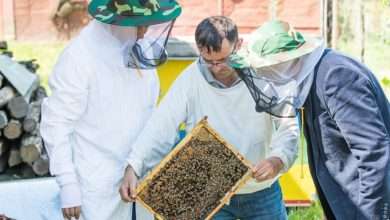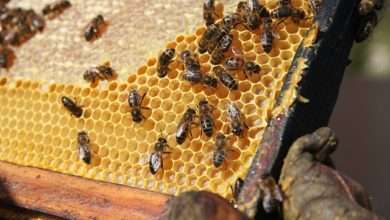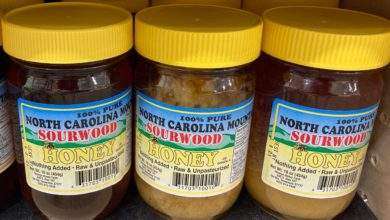How to Start Beekeeping in California

The Fascinating World of Beekeeping: A Beginner’s Guide
Are you intrigued by the world of beekeeping and considering starting your beekeeping journey? If you’re in California and want to dive into this captivating hobby, you’ve come to the right place. In this beginner’s guide, we’ll provide you with indispensable tips and insights to help you get started.
The Benefits of Beekeeping
Beekeeping goes beyond being just a hobby; it’s a fulfilling and sustainable practice that fosters biodiversity and plays a crucial role in maintaining our ecosystem’s balance. Whether you’re interested in honey production, supporting pollination, or simply caring for these remarkable insects, this guide is for you.
With our comprehensive guide, you’ll gain the confidence and knowledge needed to begin your beekeeping adventure. So, suit up, grab your smoker, and let’s explore the fascinating world of beekeeping together!
Why Dive into Beekeeping?
- Connecting with Nature: Embarking on beekeeping allows you to forge a unique and meaningful connection with nature. It offers the chance to observe bees in their natural habitat and gain a deeper understanding of their role in the ecosystem.
- Supporting Garden Pollination: Beekeeping has a significant impact on garden pollination. A bee colony’s presence can enhance the pollination process, resulting in improved crop yields and overall garden health. By becoming a beekeeper, you can actively contribute to garden pollination and environmental well-being.
- Learning about Bee Behavior: Engaging in beekeeping offers a captivating insight into the intricate social structure of bees. It’s an educational experience that allows you to appreciate the intelligence and organization within a bee colony.
- Enjoying Honey Production: Another rewarding aspect of beekeeping is the delight of honey production. It’s a gratifying outcome of the care and dedication invested in beekeeping.
- Educational Experience for Children: Beekeeping can provide valuable lessons about nature, sustainability, and the importance of bees in the ecosystem for children. It’s a great educational experience that can instill a love for nature and its preservation.
- Therapeutic Relaxation for Adults: For adults, beekeeping can be a source of therapeutic relaxation. It offers a peaceful and meditative experience, allowing individuals to unwind and reconnect with the natural world.
Beekeeping is a multifaceted and rewarding venture that offers numerous benefits for both individuals and the environment. Whether you’re drawn to the educational, environmental, or therapeutic aspects of beekeeping, it’s a fulfilling activity with plenty to offer.
California’s Unique Climate and Agricultural Landscape for Beekeeping
California’s diverse climate and vast agricultural landscape make it an ideal location for beekeeping. With its Mediterranean climate, fertile soils, and diverse vegetation, this explains why California is renowned for its thriving beekeeping industry.
California’s Mediterranean Climate:
- California’s Mediterranean climate is characterized by mild, wet winters and warm, dry summers.
- This climate allows for a long nectar and pollen-producing season, which is vital for honeybee colonies to thrive.
- The absence of extreme temperature fluctuations provides a stable environment for the bees throughout the year.
Diverse Floral Resources:
- California’s diverse agricultural landscape offers an abundance of floral resources for bees.
- The state is the leading producer of several crops, including almonds, avocados, citrus fruits, and berries.
- These crops, along with a wide array of native wildflowers, provide a constant source of nectar and pollen for honeybees.
- The wide variety of flowering plants allows beekeepers to produce a diverse range of high-quality honey with unique flavors and characteristics.
Pollination Services:
- The extensive agricultural industry in California heavily relies on honeybee pollination.
- Beekeepers transport their colonies to various crops for pollination services, thereby ensuring abundant yields and higher quality fruits and nuts.
- Almond growers, in particular, rely on honeybee colonies from across the country, making California the largest destination for managed honeybee colonies during almond bloom season.
- This interdependence between beekeepers and farmers contributes significantly to the success of both industries.
California’s unique climate and agricultural landscape provide an exceptional setting for successful beekeeping. The state’s Mediterranean climate, diverse floral resources, and the critical role of pollination services have made California a hub for beekeepers and vital for the nation’s food production.
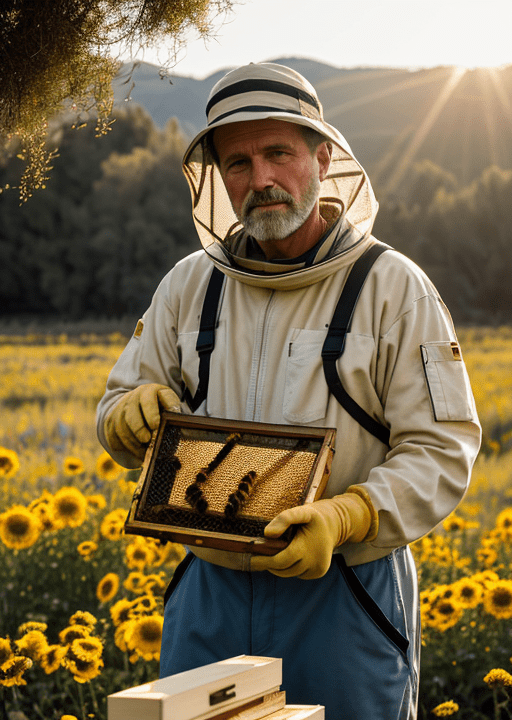
Legal Requirements and Regulations for Beekeeping in California
Beekeeping is a popular hobby and industry in California, but there are strict legal requirements and regulations that must be followed to ensure the health and safety of both the bees and the community.
- All beekeepers are required to register their hives with the local agricultural commissioner. This helps the state track the location of hives and monitor for diseases that could spread among bee populations.
- Beekeepers are also required to follow strict guidelines for hive placement to prevent nuisance issues for neighbors. Hives must be located a certain distance from property lines, roads, and public spaces to minimize disturbances to the surrounding area.
- California has specific regulations regarding the use of pesticides near beehives to protect the bees from harmful exposure. Beekeepers must be aware of these regulations and take steps to ensure their bees are not adversely affected.
- In addition to state regulations, beekeepers must also adhere to any local ordinances that may impact their beekeeping operation. These ordinances can vary by city or county and may include restrictions on hive placement, noise levels, or the number of hives allowed in a certain area.
- Beekeepers in California should also be aware of any zoning regulations that could affect their beekeeping activities. Some areas may have restrictions on the keeping of bees in residential neighborhoods or may require special permits for larger beekeeping operations.
Overall, it is important for beekeepers in California to be familiar with and comply with all legal requirements and regulations to ensure the success of their beekeeping operation and to protect the health and well-being of the bees and the surrounding community.
Essential Equipment for Beekeeping in California
Beekeeping in California can be a fulfilling and rewarding hobby, but it requires the right tools and equipment to ensure success. The state’s varied climate and environmental factors necessitate the use of appropriate equipment to properly care for bees and maximize honey production.
Beehive Components
Setting up a beehive requires the right components to provide a suitable environment for the bees. The most common type of hive used in beekeeping is the Langstroth hive, which consists of several crucial components:
- Bottom Board: The bottom board serves as the base of the hive, providing a sturdy foundation for the entire structure.
- Brood Boxes: These deep wooden boxes house the brood frames where the queen lays her eggs and the bees raise their young.
- Honey Supers: Shallower boxes placed above the brood boxes to store surplus honey produced by the bees.
- Frames and Foundation: Wooden or plastic frames that hold beeswax sheets (foundation) for bees to build comb and store honey.
- Inner and Telescoping Cover: The inner cover is placed on top of the uppermost brood box, providing insulation and ventilation. The telescoping cover acts as a protective top covering to shield the hive from the elements.
Ensuring that you have the right equipment is crucial for successful beekeeping in California.
Protective Gear for Beekeepers in California
Beekeeping is a rewarding and fulfilling hobby, but it also comes with inherent risks, particularly the risk of bee stings. For this reason, it is essential for beekeepers to invest in the proper protective gear to ensure their safety and well-being while tending to their beehives. In California, where beekeeping is a popular activity, the following protective gear is considered essential for beekeepers:
- Beekeeping Suit: A beekeeping suit is a full-body garment made of lightweight, breathable material that provides protection from bee stings during hive inspections and honey extraction. It is designed to cover the entire body and includes a veil to protect the face, allowing beekeepers to work with their hives without the fear of getting stung.
- Bee Gloves: Durable gloves made specifically for beekeeping are crucial for protecting the hands from bee stings. These gloves provide an additional layer of defense and allow beekeepers to handle the hive and its components without the risk of being stung on the hands.
- Beekeeping Boots: Beekeeping boots are tall, sturdy footwear designed to prevent bees from crawling up pant legs and provide additional protection for the feet and lower legs. These boots are an essential part of a beekeeper’s protective gear, as they help prevent bee stings on the lower extremities and provide stability and support while working around the hive.
The use of protective gear is not just a matter of safety—it is also a reflection of responsible beekeeping practices. By wearing the appropriate gear, beekeepers can minimize the risk of being stung, which ultimately benefits the health and well-being of both the beekeeper and the bees.
Additionally, the use of protective gear allows beekeepers to work confidently and without fear, leading to a more enjoyable and productive beekeeping experience.
Essential Tools for Hive Management
Beekeeping requires the use of various tools to manage the beehive efficiently. These tools are essential for ensuring the well-being of the bees and for the convenience of the beekeeper during hive inspections and manipulations.
- Hive Tool: The hive tool is a versatile instrument used for prying apart hive components, scraping off excess wax or propolis, and accessing hard-to-reach areas within the hive. This essential tool facilitates the maintenance and manipulation of bee hives.
- Smoker: A smoker is a device used to release cool, white smoke, which helps calm the bees and makes hive inspections and manipulation easier. The gentle use of smoke during hive management can aid in reducing bee aggression and ensuring a smoother beekeeping experience.
- Bee Brush: During hive inspections, a bee brush is an indispensable tool used to gently remove bees from frames and hive components. This soft-bristled brush allows beekeepers to handle bees with care and precision, minimizing disturbance to the hive. Many experienced beekeepers prefer a horsehair bee brush over others, as the bees are less likely to get stuck in the horsehair.
- Queen Excluder: A queen excluder is a metal or plastic barrier that prevents the queen from laying eggs in the honey storage area by separating the brood box from the honey supers. This tool is essential for maintaining the separation of the queen and the honey production area within the hive. A metal queen excluder is preferred by most beekeepers.
- Hive Feeder: The hive feeder is used to provide supplementary nutrition or water for bees during periods of scarcity. This tool is crucial for ensuring the health and sustenance of the bee colony, especially during challenging times.
The effective management of a beehive requires the use of essential tools such as the hive tool, smoker, bee brush, queen excluder, and hive feeder. These tools play a vital role in ensuring the well-being of the bees and the ease of hive inspections and manipulations for the beekeeper.
Honey Extraction Equipment
Beekeeping in California is a rewarding and fruitful endeavor, especially when it comes to harvesting honey. To ensure a successful honey extraction process, it is crucial to have the right equipment at your disposal.
- Honey Extractor: A honey extractor is a mechanical device that plays a vital role in the honey extraction process. It works by spinning honey frames and utilizing centrifugal force to extract the honey, making the process efficient and effective.
- Uncapping Knife: An uncapping knife is a heated tool specifically designed for removing the beeswax caps from frames before honey extraction. This allows for easy access to the honey and ensures a smooth extraction process.
- Strainer: A fine mesh filter, such as a strainer or sieve, is essential for removing impurities and wax particles from the extracted honey. This step is crucial for achieving high-quality, pure honey that is free from any debris.
- Storage Containers: Once the honey has been extracted, it needs to be stored in airtight containers to ensure its freshness and longevity. Jars or bottles are commonly used for this purpose, providing a secure and suitable environment for storing harvested honey.
The Importance of Having the Right Equipment
Having the right equipment is vital for the success of honey extraction in beekeeping. It not only streamlines the extraction process but also contributes to the overall well-being of the bees and the quality of the honey produced.
By investing in the necessary tools, protective gear, and extraction equipment, beekeepers can create an optimal environment for the bees and maximize honey production.
Selecting the Perfect Location for Your Beehives
When it comes to beekeeping, the location of your beehives plays a crucial role in the success of your colonies. The right location can significantly impact the bees’ ability to thrive and produce high-quality honey. Before you set up your beehives, it’s essential to carefully consider the following factors to ensure an optimal environment for your bees:
- Sun Exposure: One of the key factors to consider when choosing a location for your beehives is sun exposure. Honeybees thrive in sunny environments, so it’s important to select a location where the hives will receive ample sunlight throughout the day. Experienced beekeepers often recommend facing the colonies toward the morning sun to ensure they receive the optimal amount of sunlight.
- Wind Protection: Providing your beehives with some degree of wind protection is essential for the well-being of your bees. Strong winds can disorient bees and hinder their foraging efforts. When planning the placement of your hives, consider natural windbreaks such as trees, fences, or buildings to shield the colonies from strong winds.
- Accessibility: Easy access to the beehives for regular inspections, maintenance, and honey collection is important for beekeepers. To ensure ease of access, place the hives on level ground, away from obstructions, making these tasks more manageable.
- Distance from Human Activity: To minimize the risk of disturbances or conflict, it’s important to keep the beehives at a safe distance from areas with high human activity. This can help create a peaceful and undisturbed environment for your bees to thrive.
- Water Source: Bees require water for various activities within the hive, so it’s crucial to ensure that there’s a nearby water source for them to access. Be mindful of providing a suitable water source when selecting the location for your beehives.
- Vegetation and Floral Resources: Choosing a location with abundant floral resources is vital to ensure that bees have access to nectar and pollen to sustain the colony. Consider the availability of floral resources when selecting the site for your beehives.
- Space: Preventing overcrowding is important to avoid competition among colonies. Provide enough space between hives to ensure that each colony has ample room to thrive and flourish.
- Predators: Identifying and addressing potential threats from predators such as bears, skunks, or raccoons is essential when selecting a location for your beehives. Taking preemptive measures to protect your colonies from predators can greatly contribute to their well-being.
The success of your beekeeping endeavors greatly depends on the location of your beehives. By carefully considering these factors and making informed decisions, you can create an optimal environment for your colonies to thrive and produce high-quality honey.
Sourcing High-Quality Bees in California
Beekeeping in California requires a reliable source of high-quality bees to ensure the success of your apiary. With its abundant agriculture and favorable environment for beekeeping, California offers various options for obtaining bees.
- Local Beekeeping Associations: One of the most convenient and reliable sources for acquiring bees in California is through local beekeeping associations. These associations have established connections with reputable breeders and even breed bees themselves. By reaching out to your nearest local beekeeping association, you can get recommendations on trusted bee suppliers within the state. These associations not only provide healthy and well-maintained bees but also offer valuable resources, mentorship, and support throughout your beekeeping journey.
- Bee Breeders and Suppliers: California is home to numerous bee breeders and suppliers specializing in providing high-quality bees for apiaries. These breeders offer both package bees and nucleus colonies (nucs) for purchase. Package bees consist of a queen accompanied by a sufficient number of worker bees, while nucs consist of a queen, worker bees, and comb with brood, providing a head start to your colony. Purchasing from bee breeders and suppliers ensures the acquisition of healthy and productive bees for your apiary, albeit with some planning and additional costs.
- Local Beekeepers: Another valuable source for acquiring bees in California is through local beekeepers in your area. Experienced beekeepers often have surplus bees they can sell or even offer swarm captures. Engaging with local beekeepers not only provides you with access to bees but also enables you to tap into their expertise, learn from their experiences, and establish valuable connections within the beekeeping community.
- Online Bee Suppliers: The advent of e-commerce has made it possible to access bees from various suppliers across the country, including in California. Online bee suppliers offer the convenience of ordering bees from the comfort of your home and provide a wide range of choices in terms of bee packages, nucs, and different bee breeds. Carefully researching and choosing reputable online suppliers with good reviews is crucial to ensure the quality and health of the bees being shipped.
- Swarm Traps: Placing swarm traps can be an excellent strategy to attract swarming bees and capture them effortlessly. Swarming is a natural occurrence in the life cycle of honey bees, and by setting up swarm traps in strategic locations, you can increase your chances of capturing a passing swarm. These swarms can then be integrated into your apiary, significantly boosting its size and productivity.
- Bee Removal Services: Contacting local bee removal services can be a cost-effective way to acquire bees. These services are responsible for capturing and relocating bees that may pose a threat to public safety. By expressing your interest in adopting a colony, you can provide them with a suitable home. While this method may require patience and a bit of luck, it can be an exciting and economical way to source bees while contributing to the preservation of honeybee populations in California.
Quality bees are essential for a thriving apiary, and California offers multiple sources for acquiring them. Whether it’s through local associations, breeders, online suppliers, or even through swarm traps and bee removal services, beekeepers in California have access to a variety of options for sourcing bees.
The Benefits of Joining a Beekeeping Club
- Networking Opportunities: Joining a beekeeping club provides access to a network of individuals who share a passion for beekeeping. This network enables the exchange of ideas, experiences, and knowledge, as well as the formation of beneficial partnerships.
- Learning and Education: Beekeeping clubs organize meetings, workshops, and educational events to expand members’ knowledge and expertise in beekeeping. These events cover a wide range of topics, allowing beekeepers to enhance their skills and stay updated with the latest trends and best practices.
- Support and Mentorship: Members have access to a community of experienced beekeepers who are willing to provide guidance, tips, and support. This mentorship is particularly beneficial for beginners who may have many questions and uncertainties about beekeeping.
- Access to Resources: Many beekeeping clubs offer valuable resources such as beekeeping libraries, equipment rentals, bulk purchasing options for supplies, and apiary sites for members to keep their hives. These resources can save time and money while providing the necessary tools for success.
- Social Engagement: Participating in club activities allows members to be part of a community that extends beyond beekeeping. Social events and group outings provide the opportunity to build friendships and connections with like-minded individuals.

Joining a beekeeping club can significantly enhance the beekeeping experience by providing networking opportunities, learning and education, support and mentorship, access to valuable resources, and social engagement. Whether you are a beginner or an experienced beekeeper, the benefits of joining a beekeeping club are numerous and can greatly enhance your beekeeping journey.
Here is a List of Local Bee Clubs in California:
| Alameda County Beekeepers Association |
| Beekeepers Association of Southern CaliforniaBeekeepers of Napa Valley |
| Beekeepers’ Guild of San Mateo County |
| Central Valley Beekeepers |
| Delta Bee Club |
| Gilroy Beekeepers Association |
| Honey Love Urban Beekeepers |
| Humboldt County Beekeepers Association |
| Klamath Basin Beekeepers AssociationLompoc Valley Beekeepers Association |
| Los Angeles County Beekeepers Association |
| Marin County Beekeepers Club |
| Mount Diablo Beekeepers Association |
| Nevada County Beekeepers AssociationOjai Valley Bee ClubOrange County Beekeepers Association |
| Sacramento Area Beekeepers AssociationSan Diego Beekeeping Society |
| San Francisco Beekeepers Association Santa Barbara Beekeepers Association |
| Santa Clara Valley Beekeepers GuildShasta Beekeepers Association |
| Sierra Foothill Beekeepers Association |
| Sonoma County Beekeepers AssociationSouth Valley Bee Club |
- Important Tasks and Duties of Beekeepers
Beekeeping is a deeply rewarding and fulfilling endeavor that requires dedication and attention to detail. To maintain the health and productivity of bee colonies, beekeepers must adhere to a set of important tasks and responsibilities.
Hive Inspections
Regular inspections of bee hives are crucial for ensuring the well-being of the bees and the overall productivity of the colony. During these inspections, beekeepers should carefully observe the population of the hive, the pattern of brood development, the availability of honey stores, and any indications of disease or pests.
Feeding and Supplementing
Depending on the availability of nectar and pollen sources, beekeepers may need to provide supplementary feeding to their bees. This is particularly important during dearth periods when natural food sources may be scarce. Supplemental feeding can involve providing sugar water or commercially available bee supplements to ensure that the bees have an adequate food supply.
Supering and Harvesting: Maximizing Honey Production
In regions like California, where honey flows can be abundant, beekeepers must add supers or additional bee boxes to their hives to accommodate surplus honey production. Monitoring the hive’s honey stores and harvesting excess honey at the right time is essential to maintain the hive’s productivity.
Swarm Prevention and Management
The warm climate of California can contribute to rapid colony growth and increase the risk of swarming among bee colonies. Beekeepers must implement effective swarm prevention techniques to minimize the likelihood of swarming, such as providing ample space within the hive, conducting regular inspections, and splitting colonies when necessary.
Queen Management: Ensuring Colony Vitality
Effective queen management is crucial for maintaining the overall health and productivity of bee colonies. Beekeepers must monitor the performance of the queen and take necessary measures to ensure her continued health and productivity. This may involve requeening the colony when necessary to maintain its strength and vitality.
Beekeeping involves a range of vital duties and responsibilities, all of which are essential for the well-being and productivity of bee colonies. By maintaining a keen focus on hive inspections, feeding and supplementing, supering and harvesting, swarm prevention and management, and queen management, beekeepers can ensure the long-term health and success of their colonies.
Planting a Honeybee-Friendly Garden – Native Pollinator Plants
As pollinators, bees play a vital role in food production and maintaining biodiversity. By creating a garden that nurtures honeybees and supports native pollinators, we can contribute to their conservation efforts and foster a thriving ecosystem.
Here is a list of native pollinator plants specifically suited for California:
- California poppy (Eschscholzia californica): Known for its vibrant orange blooms, the California poppy is a favorite among native pollinators such as bees and butterflies.
- Purple sage (Salvia leucophylla): This fragrant plant produces beautiful purple blooms that are highly attractive to bees and hummingbirds.
- Hummingbird sage (Salvia spathacea): As the name suggests, this plant is a favorite among hummingbirds, but it also attracts bees and butterflies with its pink tubular flowers.
- California fuchsia (Epilobium canum): With its bright red, tubular flowers, California fuchsia is a favorite among hummingbirds and bees.
- Coyote mint (Monardella villosa): This low-maintenance plant produces clusters of pink or purple flowers that are attractive to bees and butterflies.
- Goldenrod (Solidago californica): Goldenrod is a great late-season bloomer that provides nectar for bees and butterflies when other flowers may be scarce.
- Yarrow (Achillea millefolium): Yarrow is a hardy plant that produces flat clusters of tiny flowers that are highly attractive to bees and other pollinators.
By including these native pollinator plants in your garden, you can create a haven for bees, butterflies, hummingbirds, and other important pollinators. Not only will your garden be buzzing with life, but you will also be doing your part to support the health and biodiversity of California’s native ecosystems.
Selling Honey in California
Selling honey in California can be a profitable venture for beekeepers, but it’s important to understand the regulations and requirements that come with selling honey in the Golden State.
To legally sell honey in California, beekeepers must adhere to specific regulations set forth by the California Department of Food and Agriculture.
One of the first steps to selling honey in California is obtaining the necessary licenses and permits. Beekeepers must register with the California Department of Food and Agriculture and obtain a Certified Producer certificate. This certificate allows beekeepers to sell their honey at farmers markets and other direct-to-consumer venues.
In addition to licensing requirements, beekeepers must also adhere to strict labeling laws when selling honey in California. Honey products must be labeled with the producer’s name and address, the net weight of the product, and a list of ingredients. Labels must also include a statement of identity, such as “Pure California Honey,” to ensure consumers know the origin of the product.
When it comes to marketing honey in California, beekeepers have several options to reach customers. Farmers markets, specialty grocery stores, and online platforms are all popular venues for selling honey in the state. Beekeepers can also consider hosting tastings or workshops to educate consumers about the benefits of locally-produced honey.
For beekeepers looking to expand their knowledge and network with other honey producers in California, there are a variety of resources available. Local beekeeping associations, workshops, and conferences offer valuable information and networking opportunities for beekeepers looking to grow their business.
Overall, selling honey in California can be a rewarding endeavor for beekeepers, but it’s important to stay informed about regulations, licensing requirements, and best practices for marketing honey in the state. By following these guidelines and taking advantage of available resources, beekeepers can successfully sell their honey products in California and meet the growing demand for local, sustainable honey.
Resources for Continued Learning and Education in Beekeeping in California
Are you looking to expand your knowledge and skills in beekeeping in California? Whether you are a beginner or an experienced beekeeper, there are plenty of resources available to help you continue learning and growing in this rewarding hobby.
One great resource is the California Master Beekeeper Program (CAMBP), which offers a series of courses and workshops for beekeepers of all levels. These classes cover a wide range of topics, from hive management to bee biology, and are taught by experienced beekeepers and researchers. By completing the CAMBP program, you can earn certification as a Master Beekeeper and demonstrate your knowledge and expertise in the field.
Another valuable resource for beekeepers in California is local beekeeping associations. These organizations often host meetings, workshops, and beekeeping clinics where members can network with other beekeepers, share tips and advice, and learn from guest speakers. By joining a local beekeeping association, you can connect with a community of like-minded individuals who share your passion for beekeeping.
University extension programs are also a great resource for beekeepers looking to further their education. Many universities in California offer beekeeping courses, seminars, and online resources that cover a wide range of topics related to beekeeping. These programs are taught by experts in the field and provide valuable information and insights that can help you improve your beekeeping practices.
Overall, there are plenty of resources available to help beekeepers in California continue learning and expanding their knowledge. Whether you choose to participate in the CAMBP program, join a local beekeeping association, or take advantage of university extension programs, there are endless opportunities to further your education and grow as a beekeeper. By investing in your education and skills, you can become a more knowledgeable and successful beekeeper while also contributing to the health and well-being of your local bee populations.
Conclusion
Starting beekeeping in California comes with its challenges, but the rewards make it all worthwhile.
By following the steps outlined in this article, you have acquired the foundations to become a successful beekeeper. From setting up your hive to harvesting honey and sharing your delicious nectar with others, you are now well on your way to enjoying all the incredible benefits that beekeeping has to offer.
So, put on your beekeeping suit, grab your smoker, and let’s dive into the fascinating world of beekeeping together! Your bees are waiting to embark on this exciting journey with you. Happy beekeeping!
FAQ’s
Can anyone become a beekeeper?
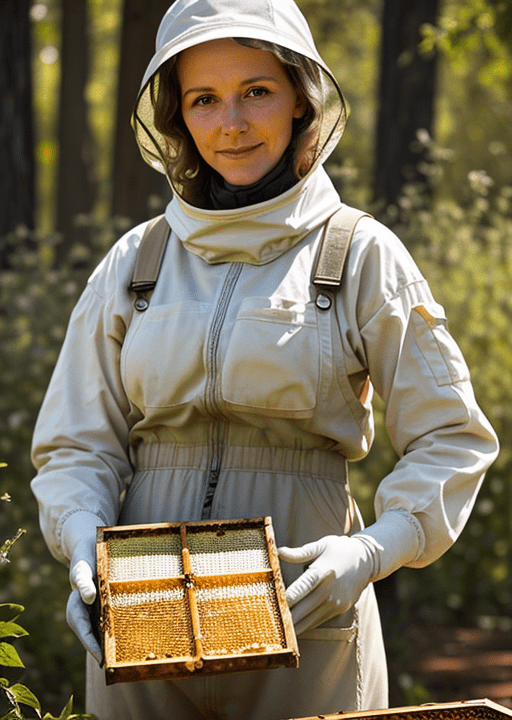
- Yes, anyone with the right knowledge, skills, and commitment can become a successful beekeeper.
Do beekeepers need protective gear when using hive management tools?
- Yes, beekeepers should always use protective gear, including a bee suit, veil, and gloves, when handling hive management tools.
How do I start beekeeping in California?
- To start beekeeping in California, you need to acquire knowledge about beekeeping practices, including proper hive management and identifying potential challenges. You also need to obtain the necessary equipment, such as beehives, frames, protective clothing, and tools. Additionally, consider joining local beekeeping associations for valuable resources and support.
How should I choose beekeeping protective clothing?
- When selecting beekeeping protective clothing, prioritize safety and comfort. Look for a full-body suit or jacket made of durable, lightweight fabric that provides ample protection against bee stings. Ensure that the clothing has a veil or hood that securely covers your face and neck, as those are particularly sensitive areas. Additionally, gloves, beekeeping boots, and a hat can further enhance your protection.
Can I keep bees in urban areas in California?
- Yes, beekeeping is possible in urban areas of California, provided there are no local regulations or restrictions against it. However, it is important to consider factors such as available forage, suitable hive placement, and the well-being of neighboring communities when practicing beekeeping in urban settings.
What is the purpose of a smoker in beekeeping?
- The purpose of a smoker is to release cool, white smoke to calm the bees during hive inspections and manipulations.
How often should hive inspections be conducted?
- Hive inspections should be conducted regularly, with the frequency depending on the season and the needs of the bee colony.
What is the most important tool for honey extraction?
- The honey extractor is considered the most important tool for honey extraction, as it plays a crucial role in the efficient removal of honey from frames.
Please note:
The FAQ answers provided here are general guidelines for beekeeping in California. It is always recommended to consult local beekeeping authorities, experienced beekeepers, or relevant associations for specific and up-to-date information and regulations.
